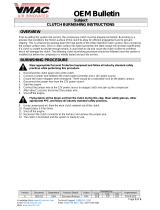
safetymessagesthatyoumustfollowtoavoid
accidents.Thissymbolwillappearwiththeword
Danger,Warning,orCaution.
•Dangerindicatesanimminentlyhazardous
situationwhich,ifnotavoided,willresultindeath
orseriousinjury.
•Warningindicatesapotentiallyhazardous
situationwhich,ifnotavoided,couldresultin
deathorseriousinjury.
•Cautionindicatesapotentiallyhazardoussituation
which,ifnotavoided,mayresultinminoror
moderateinjury.
g000502
Figure2
Safety-alertsymbol
Contents
Safety.......................................................................4
GeneralSafety...................................................4
SafetyandInstructionalDecals..........................4
Setup........................................................................7
1InstallingtheSteeringWheel............................7
2ConnectingtheBattery....................................7
3CheckingtheFluidLevelsandTire
Pressure.........................................................8
4BurnishingtheBrakes......................................8
5ReadingtheManualandViewingthe
SetupMaterial.................................................9
ProductOverview...................................................10
Controls............................................................11
Specications..................................................14
Attachments/Accessories.................................14
BeforeOperation.................................................15
BeforeOperationSafety...................................15
PerformingDailyMaintenance..........................15
CheckingtheTirePressure...............................15
AddingFuel......................................................16
BreakinginaNewMachine..............................16
DuringOperation.................................................17
DuringOperationSafety...................................17
OperatingtheCargoBed..................................18
StartingtheEngine...........................................20
StoppingtheMachine.......................................20
ShuttingOfftheEngine.....................................20
LoadingtheCargoBed.....................................20
AfterOperation....................................................21
AfterOperationSafety......................................21
HaulingtheMachine.........................................22
TowingtheMachine..........................................22
TowingaTrailer................................................22
Maintenance...........................................................23
MaintenanceSafety..........................................23
RecommendedMaintenanceSchedule(s)...........23
DailyMaintenanceChecklist.............................25
MaintainingtheMachineunderSpecial
OperatingConditions....................................25
Pre-MaintenanceProcedures..............................26
PreparingtheMachineforMaintenance............26
LiftingtheMachine...........................................26
AccessingtheHood..........................................27
Lubrication..........................................................27
GreasingtheFrontWheelBearings..................27
EngineMaintenance...........................................30
EngineSafety...................................................30
ServicingtheAirFilter.......................................30
ServicingtheEngineOil....................................31
FuelSystemMaintenance...................................33
InspectingFuelLinesandConnections.............33
ReplacingtheFuelFilter...................................33
ElectricalSystemMaintenance...........................34
ElectricalSystemSafety...................................34
ServicingtheBattery.........................................34
ReplacingtheFuses.........................................35
MaintainingtheHeadlights...............................35
DriveSystemMaintenance..................................37
MaintainingtheTires........................................37
InspectingtheSteeringandSuspension
Components.................................................38
AdjustingtheFrontWheelAlignment................39
CheckingtheTransaxle-FluidLevel..................40
ChangingtheTransaxleFluid...........................40
CheckingandAdjustingNeutral........................41
InspectingthePrimaryDriveClutch..................41
MaintainingthePrimaryDriveClutch................42
CoolingSystemMaintenance..............................42
CoolingSystemSafety.....................................42
CleaningtheEngine-CoolingAreas..................42
ServicingtheRadiator......................................43
BrakeMaintenance.............................................44
InspectingtheBrakes.......................................44
AdjustingtheParking-BrakeHandle.................44
AdjustingtheBrakeCables...............................44
CheckingtheBrake-FluidLevel........................45
ChangingtheBrakeFluid.................................46
BeltMaintenance................................................46
ServicingtheDriveBelt.....................................46
CheckingtheBelt-PullBumper.........................47
ChassisMaintenance...........................................47
AdjustingtheCargo-BedLatches.....................47
Cleaning..............................................................48
WashingtheMachine.......................................48
Storage...................................................................49
StorageSafety..................................................49
StoringtheMachine..........................................49
3























